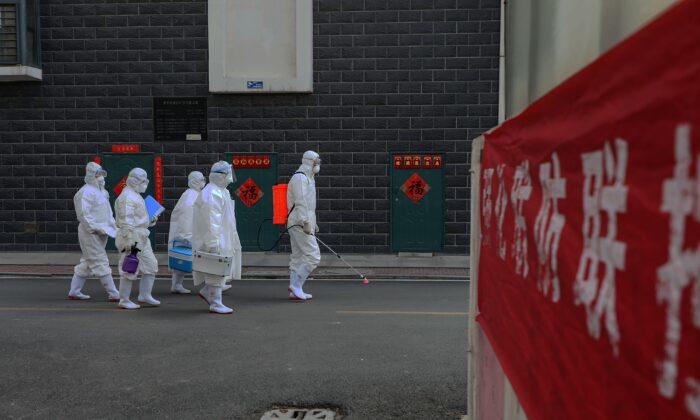Leaked Docs Reveal Covid-19 Infections Up To 52 Times Higher Than ‘Official’ Figures In China’s Shandong Province
Authored by Nicole Hao via The Epoch Times,
The novel coronavirus outbreak in eastern China’s Shandong province is much worse than the officially reported, according to a series of internal government documents obtained by The Epoch Times.
Between Feb. 9 to 23, Shandong authorities underreported the number of infections every day, according to internal data compiled by the Shandong Centers for Disease Prevention and Control (CDC). The latter kept a tally of the number of patients who tested positive for the virus during nucleic acid testing—using a diagnostic kit to test body samples and detect whether they contain the virus’s genetic sequence.
The Shandong CDC daily new infection numbers ranged from being 1.36 times to 52 times greater than the officially published data by the Shandong health commission and China’s National Health Commission.
As of Feb. 25, the Shandong government stated that there were a total of 755 infections in the province. But the internal document showed that 1,992 people had tested positive for the virus via nucleic acid testing as of Feb. 23.
The government publicly stated that there were four newly diagnosed coronavirus patients on Feb. 22, but the internal document said that 61 patients were diagnosed with the virus that day.
In recent days, official data has shown new infections leveling off. For example, on Feb. 25, the National Health Commission reported only a total of nine new diagnosed cases outside of Hubei province, where the outbreak is most severe.
In fact, Shandong alone had new infections in the double digits daily. On Feb. 20, new infections spiked, with 274 testing positive.
To date, this is the most definitive evidence that Chinese authorities routinely underreport cases. Previously, The Epoch Times interviewed staff at funeral homes in the city of Wuhan, the capital of Hubei, who said they had to work round the clock in order to keep up with the dramatic increase in workload.
Health experts have also hypothesized that Chinese official figures are inaccurate, based on their statistical modeling. Recently, a group of American researchers published a study, not yet peer-reviewed, in which they suggested cumulative infections and deaths in China could be “substantially higher” than officially stated—by a factor of 5 to 10.
U.S.-based China commentator Tang Jingyuan told The Epoch Times that authorities reporting fewer infections was likely a tactic to convince Chinese citizens that the virus’s spread was contained and thus, it would be safe to return to work.
Chinese businesses were shut down for the Lunar New Year holiday, which was extended in order to prevent cross-infection in the workplace. The central government, fearing the economic inactivity could have long-term impact, asked firms to resume operations on Feb. 10.
“It [Beijing] is trying to create an image that most of the country is safe enough to resume production,” Tang said.
Shandong
The internal data shared with The Epoch Times includes a breakdown of diagnostic results from all 16 prefectural-level municipalities in Shandong province, which were sent in an email to the disease control department of the Shandong health commission.
The Shandong CDC compiled daily statistical reports about coronavirus diagnoses, tallying positive test results at all hospitals in the province that were qualified to conduct such testing.
For example, on Feb. 22, Qishan Hospital in Yantai city tested 229 patients. 12 of them were diagnosed with the coronavirus.
Qishan Hospital is a dedicated infectious disease hospital.
At times, the Shandong government reported one or two new diagnoses to the public, when the internal data showed much more.
-
On Feb. 22, for example, the government reported two newly diagnosed cases in the day prior, but the real data was 59.
-
On Feb. 20, the government reported two newly diagnosed cases for Feb. 19, but the real data was 49.
-
And on Feb. 19, the government reported one newly diagnosed case in the day prior, but the real data was 52.
For the period between Feb. 8 to Feb. 22, the government announced that there were 347 newly diagnosed cases, but the internal data shows 1,072 new patients—more than 3 times the published figure.
Diagnostic Kit Not Sufficient?
One Chinese researcher suggested that diagnostic kits alone would not be able to detect all the virus-infected patients.
“This disease [coronavirus] has a character, which is not all patients can be detected positive when use nucleic acid testing,” Wang Chen, director of China’s Academy of Medical Sciences and a critical care medicine expert, told state-run broadcaster CCTV on Feb. 5.
Wang explained that although nucleic acid testing is currently the only official test method that Chinese medical staff use to diagnose coronavirus, the result is not accurate.
“Only 30 to 50 percent of the patients present positive,” according to Wang.
He explained that all patients who test positive are infected with the coronavirus, but another 50 to 70 percent of patients are actually infected but cannot be detected by nucleic acid testing.
Tyler Durden
Wed, 02/26/2020 – 12:15
